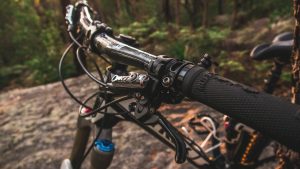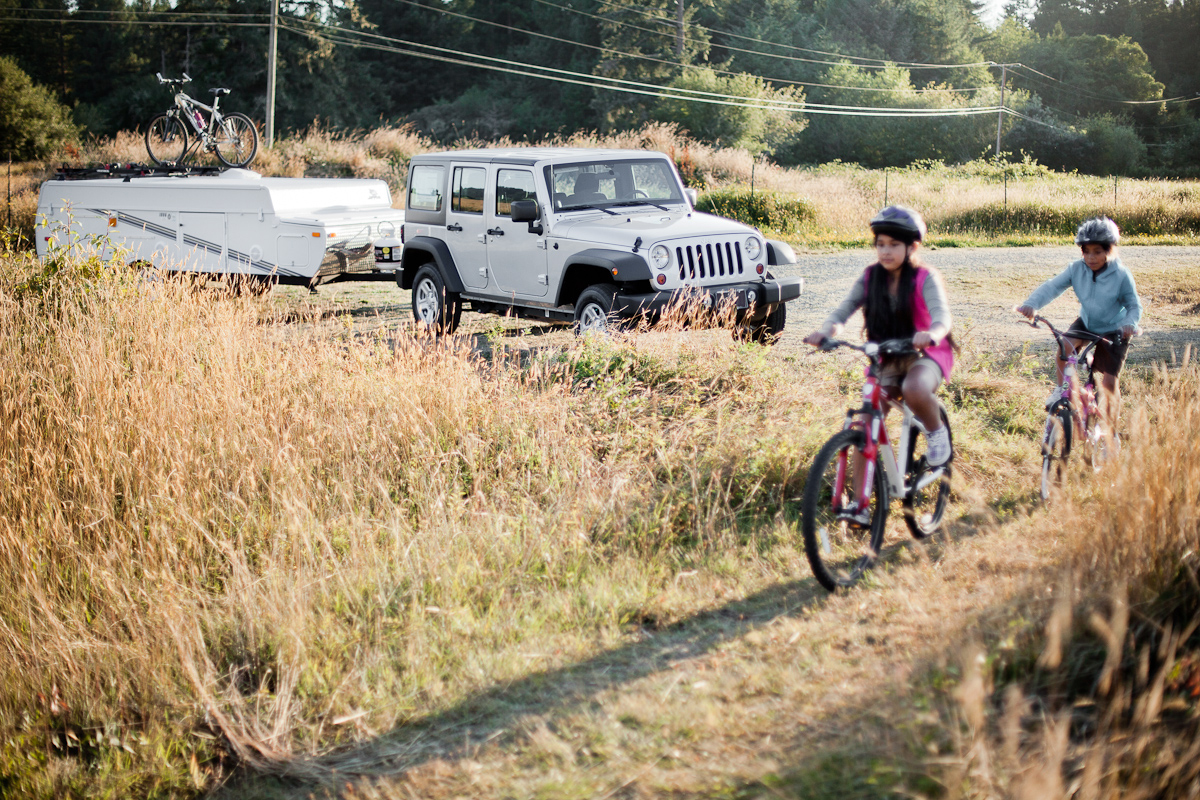Biking is routinely ranked as one of the top activities for campers because of a bike’s ease of use, fitness capability, and its capacity to be a mode of alternative transportation. How do you travel with bikes and an RV? What about kids and pets? Bike security? We discuss some of these important details in this article.
Getting to the Campsite
You have a couple options for transporting your bikes when you’re RVing. You can either keep them outside or inside.
Inside is an option if you have a sports utility trailer, which has a separate “garage” for transporting and parking toys such as ATVs, dirt bikes, small fishing boats, or even a golf cart. You may have space in the bed of a pickup truck in which to transport bikes, if it’s not being used for anything else. Even some camper vans may have space for a bike inside. If you store your bike inside of any type of compartment, make sure it’s securely stored so that it doesn’t jostle around.
Most campers, however, end up putting their bikes on the back, top, or front of their RV or vehicle. There are hitch-mounted bike racks, which can carry up to four bikes. Make sure to look for a bike rack that is made of solid materials, easy to attach and detach, and works well with your RV or vehicle, depending on how you choose to transport it. There are also ladder-mounted racks, which utilize the ladder on the back of the RV. Another option for the back of an RV is the bumper-mounted rack if a hitch isn’t available. This leaves a ladder accessible Alternatively, you may choose to travel with your bike on the nose of the RV utilizing a hitch-mount-designed bike rack (not too tall).
Crossbars and roof racks, some designed for the top of a pop-up camper, utilize typically unused space: the top of a vehicle. These racks are usually fairly inexpensive. Many , however, only transport one or two bikes at a time, and you need to make sure the bikes are attached correctly so that they don’t go awry when you’re driving down the road. This option can be cumbersome for packing and unpacking, but it can be a great option for smaller vehicles.
Tagging Along: Kids and Pets
For families with small children too young to ride their own bikes, or too young to ride bikes a lengthy distance, everyone can still go along for a ride. Bicycle trailers let one or two little ones (usually ages 1-5) ride along inside a soft-sided carriage behind mom or dad. They typically have vents on the sides to allow airflow, a foldable or zippered front “hatch,” and are brightly colored. Some of these bike trailers convert intro strollers when unhooked from the bike. Some bike trailers are foldable, making them a good choice for savvy packers and frequent travelers who want to conserve space. There are some bike trailers that were designed to give parents of infants a safe place for their babies to ride, specifically, the ability to use the car seat within the bike trailer. This is ideal for head support and overall safety. If you’re looking for a recommendation for a bike trailer for kids, Two Wheeling Tots has this informative article. As with most things, it pays to do your homework.
There are also bicycle trailers specifically designed with pets in mind, making it a nice option for older dogs or dogs that can’t keep the pace on a leash and running alongside a bike.
Depending your type (and age) of passenger and overall design, bike trailers come equipped with harnesses or seat belts.
 Bike Security and Maintenance
Bike Security and Maintenance
For security, you’ll need a bike lock, which can come in the form of a lock and key or combination lock. A bike lock should be used at the campsite and if you leave your bike unattended at any trail head, farmers market, parking lot, or downtown area. You should also have an air pump for adding air to low tires, and a tire patching kit just in case one goes flat.
Some tools can come in handy if you have a bolt to tighten or a seat to fix. A tool kit should already be included in your packing list and stowed away in the RV, toad, or tow vehicle.
You should also take photos of your bikes with your camera phone or digital camera and either stored on a cloud-based photo site or printed out. Photos are handy to have as a reference in case a bike gets stolen.
Now, get out there and start pedaling!
Many Michigan trails are bike-friendly, including rail trails (Pere Marquette Trail and Haywire Grade Trail have been featured on our website). Depending on your preference, you can A majority of these trails are managed by the Michigan DNR as they are on state land, so check the Michigan DNR website for details.

